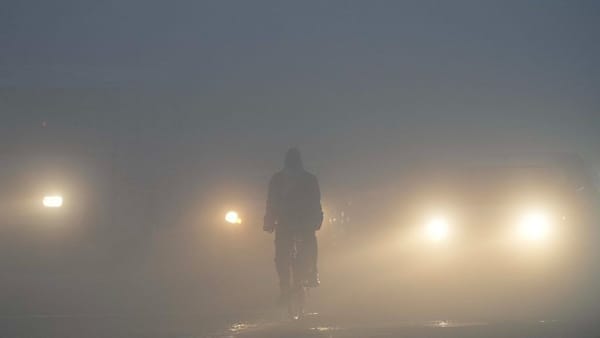Table of contents
Fog, a common meteorological phenomenon, is essentially a cloud at ground level that affects visibility and has profound implications on daily life and various sectors.
Understanding its formation, types, and impact is crucial for sectors like transportation, agriculture, and environmental management.
Formation of Fog
- Basic Mechanism: Fog forms when the air near the ground cools enough to turn its moisture into liquid water or ice. This usually happens when the temperature drops to the dew point – the temperature at which air becomes saturated with moisture.
- Key Conditions for Fog Formation
- Lower Temperatures: Essential for cooling the air to its dew point.
- Abundant Moisture: Near the surface, necessary for the formation of water droplets.
- Geographical Influences: Proximity to water bodies, valleys, and mountains.
- High Humidity: Contributes to the saturation of air.
- Cooling Processes: Including radiation cooling and advection.
Types of Fog
- Radiation Fog: This occurs when terrestrial radiation causes the ground to cool, meeting the dew point. This type is common after a rainy night.
- Advection Fog: Occurs when moist air moves over a cooler surface, chilling it to below dew point. Coastal areas often experience this type.
- Evaporation Fog: Forms when water vapor is added to cold air over warm water, as seen in lakes during early winter.
- Upslope Fog: Develops when moist air is forced up a slope, like mountains, and cools adiabatically (without heat exchange).
- Precipitation Fog: Forms when rain falls through a layer of colder, drier air, causing evaporation and saturation.
- Steam Fog: Seen over water bodies in autumn, it occurs due to the interaction between cooler air and warmer water.
- Valley Fog: Occurs in valleys, especially after rainfall, when the clearing skies allow temperatures to drop to the dew point.
- Freezing Fog: This happens when temperatures drop to or below 0°C, causing supercooled water droplets to freeze upon contact with surfaces.
- Ice Fog: Exclusive to polar and Arctic regions, forms in extremely cold conditions as the air can't hold water droplets, resulting in tiny ice crystals.
IMD Categorization of Fog
The India Meteorological Department (IMD) categorizes fog based on visibility:
- Very Dense Fog: Visibility between 0 to 50 meters.
- Dense Fog: Visibility between 51 and 200 meters.
- Moderate Fog: Visibility between 201 and 500 meters.
- Shallow Fog: Visibility between 501 meters to 1 kilometer.
Impacts of Fog
- Transportation:
- Road Safety: Reduces visibility, increasing the risk of accidents.
- Aviation Delays: Affects flights due to low visibility, requiring advanced navigation systems.
- Maritime Navigation: Poses risks for ships, especially in busy sea lanes.
- Agriculture:
- Can be both beneficial and harmful. While it provides moisture, prolonged fog can lead to diseases in crops.
- Environment and Health:
- Air Quality: Fog can trap pollutants, leading to poor air quality, especially in urban areas.
- Ecosystems: Influences biodiversity in certain fog-dependent ecosystems.
- Economic Effects:
- Impacts various sectors by disrupting transportation, affecting crop yield, and influencing energy demand.
Fog Management and Mitigation
- Forecasting and Monitoring: Advanced meteorological tools help in accurate fog forecasting, essential for transportation and other sectors.
- Infrastructure Adaptations:
- Roads: Installation of fog warning systems and improved lighting.
- Airports: Advanced Instrument Landing Systems for safe takeoff and landing.
- Environmental Management:
- Addressing pollution sources can reduce the intensity of fog, particularly in urban centers.
- Public Awareness: Educating the public on safe driving practices during foggy conditions.
We can't clear UPSC for you.
But with our personalised mentor support, you'll be ready to do it yourself.
Fog Conditions in Delhi and Northern India
The phenomenon of fog conditions in Delhi and other parts of Northern India, especially in the states of Punjab, Haryana, and Rajasthan, is a notable meteorological challenge during the winter months.
This condition significantly impacts daily life, transportation, health, and the environment. Here's a detailed analysis of fog:

Fog Formation in North-Western India
- Western Disturbances (WD) and Fog:
- WDs originating from the Mediterranean Sea bring moisture to northwestern India, crucial for fog formation. Their interaction with cold conditions can lead to fog episodes.
- Local Factors:
- Moisture Sources: Water vapor from rivers and soil contributes to fog in these regions.
- Pollution and Fog: In urban areas like Delhi, pollution exacerbates fog conditions by providing particles for moisture condensation.
Characteristics of Fog in Delhi
- Dense Fog Occurrences:
- The Indo-Gangetic Plain, including Delhi, is highly susceptible to dense fog, particularly in December and January, due to its specific geographical and climatic conditions.
- Variability and Intensity:
- Fog in Delhi shows high variability, influenced by local weather patterns such as wind, humidity, and temperature.
- Average Fog Duration:
- Statistically, Delhi experiences significant hours of very dense fog in the peak winter months.
Reasons for Heavy Fog in North India
- Infrared Cooling: A primary mechanism for fog formation, particularly during the transition from summer to winter.
- Weather Conditions: Lower temperatures during the winter months contribute to the formation of fog.
- Geographical Factors: The Indo-Gangetic plains are particularly prone to fogging due to conditions like low temperatures and moisture availability.
- Meteorological Events: WDs increase moisture levels, contributing to fog formation.
- Environmental Conditions: Factors like humidity levels and temperature variations between day and night play significant roles in fog formation.
- Human Activities: Pollution, especially in urban areas, can worsen fog conditions by providing additional nuclei for condensation.
In summary, fog conditions in Northern India, especially in Delhi and the surrounding states, result from a combination of meteorological, geographical, and environmental factors. The presence of WDs, local moisture sources, and pollution levels significantly influence the formation, intensity, and duration of fog, impacting various aspects of daily life and requiring appropriate adaptive measures.
Previous Post